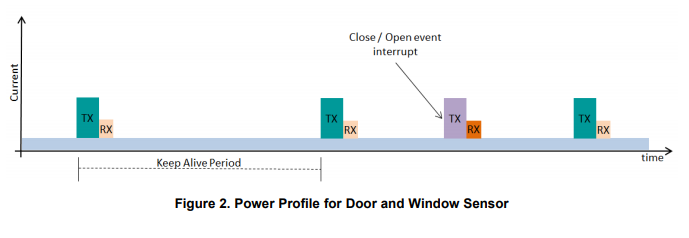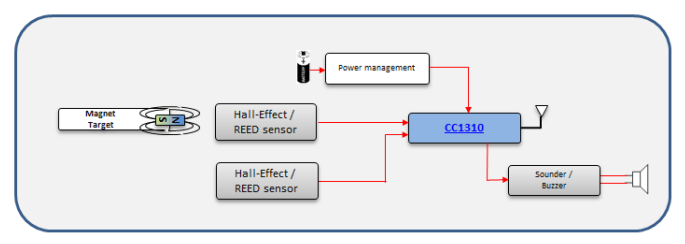SSZT857 December 2017 CC1310
Home and office security systems use door and window sensors to notify control panels if an entry point opens or closes. These sensors can be part of a complete security system or act as stand-alone sensors for specific entry points such as medicine or liquor cabinets.
Recently, there has been a shift from wired to wireless solutions given the latter’s easier installation, since wireless solutions eliminate the need to route wires through walls and ceilings. Wireless installations are more cost-effective, with quick setup times and no concerns about wire damage.
A wireless door and window sensor design presents challenges of its own, however, such as power consumption for long battery life, system robustness and long range for full building coverage. The TI SimpleLink™ Sub-1 GHz CC1310 wireless microcontroller (MCU) solves these design issues, enabling quick and easy development of a wireless door and window sensor system.
Get started developing wireless door and window sensors with these development kits and reference design:
- Sub-1 GHz CC1310 LaunchPad development kit.
- SimpleLink CC13x0 SDK.
- For more in-depth information and use-case analysis for wireless door and window sensors, read the application note, “Wireless Door and Window Sensors with Sub-1 GHz SimpleLink Wireless MCU.
- Check out this Low-Poor Door and Window Sensor Reference Design with extremely long battery life and no wiring required.
Here’s how the SimpleLink CC1310 meets the challenges of wireless door and window sensor designs:
- Long battery life. The TI SimpleLink CC1310 achieves long battery life through low power modes; power-aware software that maximizes MCU standby mode time; and a unique, proprietary sensor controller module that manages the controlled sensors while the rest of the system sleeps. The CC1310 static low-power modes are extremely low, with shutdown and standby currents of 0.185µA and 0.7µA, respectively. Additionally, the receiver (5.4mA) and transmitter modes (13.4mA at 10dBm), along with fast transition times, reduce overall current consumption. These properties enable wireless door and window sensors to operate for up to 10 years on a coin-cell battery.
Figure 1 illustrates the current profile of a typical panel-connected door and window sensor system. The sensors send periodic “keep alive” messages to the panel to report general status such as battery life. Whenever an event triggers the sensor controller module, it will immediately wake up the Arm® Cortex®-M3, the main system central processing unit (CPU) inside the CC1310, which will generate a “status changed” message and send it to the control panel. Supporting two-way communication between the sensor and control panel means that an acknowledgement follows every message sent. This acknowledgment is very important to mission-critical information.
 Figure 1 Power Profile for a Door
and Window Sensor Design
Figure 1 Power Profile for a Door
and Window Sensor Design- Robust system. The SimpleLink CC13x0 software development kit (SDK) supports the CC1310 and contains the TI 15.4 stack, an end-to-end solution for star networks based on the 802.15.4g standard, including frequency hopping and added security features. The TI 15.4 stack also implements a “listen before talk” mechanism based on carrier-sense multiple access with collision avoidance (CSMA/CA), which minimizes the amount of collisions and sends acknowledgements to confirm successful transmission.
- Full building coverage. Sub-1 GHz frequency bands have a longer range than other frequencies like 2.4GHz due to their ability to propagate well in the air, through walls and around corners. This propagation allows for full coverage in large buildings and office spaces.
Figure 2 shows an example block diagram of a wireless door and window sensor system.
 Figure 2 Wireless Door and Window
Sensor Block Diagram
Figure 2 Wireless Door and Window
Sensor Block Diagram- Cloud-connected door and window sensor system. Security systems also benefit from cloud connectivity, which allows users to monitor and control their system remotely. To enable cloud connectivity, Sub-1 GHz requires a gateway in order to buffer and translate messages in the Sub-1 GHz network into Ethernet packets, and communicate with the internet over Ethernet or Wi-Fi® interfaces.
TI provides two end-to-end sensor-to-cloud (Figure 3) solutions: one based on the Linux® platform that supports both Ethernet and Wi-Fi connectivity, and the other based on the real-time operating system (RTOS) platform that supports Wi-Fi connectivity.
 Figure 3 Sensor-to-cloud General
Block Diagram
Figure 3 Sensor-to-cloud General
Block Diagram